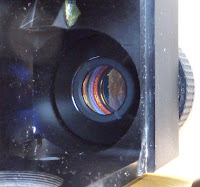*
WARNING: SOLAR OBSERVATION REQUIRES GREAT CARE AND SAFE FILTRATION.
INSTANT PERMANENT BLINDNESS CAN EASILY RESULT FROM SIMPLE MISTAKES.
NEVER LOOK AT THE SUN THROUGH ANY LENS, MIRROR OR INSTRUMENT UNLESS IT HAS BEEN FULLY TESTED AND APPROVED FOR SUCH USE. YOU FOLLOW MY EXAMPLE ENTIRELY AT YOUR OWN PERIL!
WARNING: SOLAR OBSERVATION REQUIRES GREAT CARE AND SAFE FILTRATION.
INSTANT PERMANENT BLINDNESS CAN EASILY RESULT FROM SIMPLE MISTAKES.
NEVER LOOK AT THE SUN THROUGH ANY LENS, MIRROR OR INSTRUMENT UNLESS IT HAS BEEN FULLY TESTED AND APPROVED FOR SUCH USE. YOU FOLLOW MY EXAMPLE ENTIRELY AT YOUR OWN PERIL!
As a service to those contemplating dismantling or diagnosing their PST I offer a series of images. Click on any of them for a larger image.
The various parts of the dismantled PST.
The Etalon optical group is still in place.
The two eyepiece holder components with ITF [Left] and BF5 Blocking filter.[Right]
The ITF and 5mm Blocking filter inverted. The BF5 is actually a thick block of glass. Larger blocking filters are available, built into special solar diagonal housings, at hugely increased prices.
The inside of the poorly blackened 'gold' tube. Looking towards the PST's objective. One wonders whether simple baffling would have improved the view? Perhaps they were worried about overheating the internal components? The later [blue coated] objectives had no filtering. So the focused [concentrated] heat of the sun would fall on any intermediate baffle when the PST was not perfectly aligned on the sun.
The threads at the etalon end of the gold tube. No idea why they cut the large internal thread. Nothing screws in here on present PSTs. The external thread fits into the etalon housing/tuning assembly. Note locking compound residues on the external thread. Online discussion suggest using various solvents and a wire brush. A [dry] normal toothbrush has no effect on the hardened residue.
 The main focusing pentaprism shortens the instrument to make it more
compact. Focusing is achieved by sliding the prism diagonally using the two studs in a groove in the housing for alignment. There is nothing intrinsically wrong with the system but it is poorly configured. With screw access via the covering plate provided to straighten the often twisted prism locked inside the housing.
The main focusing pentaprism shortens the instrument to make it more
compact. Focusing is achieved by sliding the prism diagonally using the two studs in a groove in the housing for alignment. There is nothing intrinsically wrong with the system but it is poorly configured. With screw access via the covering plate provided to straighten the often twisted prism locked inside the housing.
The etalon group from the 'outside' of the PST housing. Normally hidden by the gold tube and 40mm objective. The etalon looks quite clear to the naked eye with only a slightly blue cast.
Etalon from inside the housing. A negative and positive lens ensure parallel light passes through the etalon in the middle. It is the power of these lenses which demands a 20cm etalon position inside the focus of an f/10 objective. A 'shorter' or 'faster' focal ratio will stop down the objective to f/10.
ITF unscrewed from its tubular housing using a large pair of dividers. There is no obvious 'Locktight' compound but possibly a thin, rubbery thread locking agent to keep the ITF in place. The mirrored, blue coated side faces the objective. The red side towards the eyepiece.
 ITF unscrewed inside view. The matching thread to the BF5 is again loaded with Loctite residue. Which had made dismantling the PST a major headache. Meade claim 'no user adjustable parts inside.' One can understand their wariness to just leaving the threads unlocked. The world is full of drooling idiots who would quickly blind themselves. Then chase after an ambulance chaser to help to compensate them for the own drooling idiocy. It's a sort of reverse Darwin effect. The drooling idiots survive to breed. When they would otherwise, quickly make themselves unable to do anything useful with their lives.
ITF unscrewed inside view. The matching thread to the BF5 is again loaded with Loctite residue. Which had made dismantling the PST a major headache. Meade claim 'no user adjustable parts inside.' One can understand their wariness to just leaving the threads unlocked. The world is full of drooling idiots who would quickly blind themselves. Then chase after an ambulance chaser to help to compensate them for the own drooling idiocy. It's a sort of reverse Darwin effect. The drooling idiots survive to breed. When they would otherwise, quickly make themselves unable to do anything useful with their lives.
Click on any image for an enlargement.









No comments:
Post a Comment